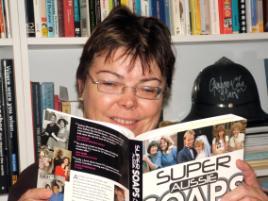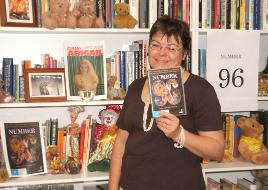Researcher recalls the night Australian television lost its virginity
Published on 15 May, 2007

Dr Margaret Rogers looks behind the scenes of Number 96 and The BoxA researcher of popular culture at Central Queensland University has been digging up the dirt on 2 cultish soap opera hits of the 1970s.
In a project she's titled Sin, Sex and Stereotypes: Number 96 and The Box on the big screen, Dr Margaret Rogers has thoroughly enjoyed her job of delving through old footage, newly-released commemorative DVDs and cultish websites that glorify these 2 iconic television success stories that eventually made it to the big screen.
"The early to mid-1970s saw the beginning of the end of the cultural cringe that had shaped Australian attitudes for so long. It was as though Australia was at last developing its own identity," explained Dr Rogers.
Number 96 debuted on Australian screens on March 1, 1972 - a date forever burned into Australian culture as "the night Australia lost its virginity".
"It was a combination of raunchiness, comedy and drama ... the writers and critics disliked it and sensors kept a vigilant watch, but viewers loved it."
"They loved the storylines that dripped with sin, sex and stereotyped characters and relied on cliffhangers engendered by the ‘knicker snipper', the ‘pantyhouse strangler' and the ‘hooded rapist'.
On February 11, 1974 The Box followed in the same vein as its predecessor and became Australia's second highest rating television series after Number 96.
"Part of its appeal was the quirky characters who were rumoured to be based on real life industry figures."
Both Number 96 and The Box were made into movies in an attempt to cash in on the viewer popularity of the television series and partly because television was still black and white and fans were able to see their favourite characters in colour on the big screen.
"The movies were cheaply made in a short time frame ... Number 96 was made in just 11 days ... but because of the success of the series, they attracted the crowds."

Dr Margaret Rogers has enjoyed looking back to the 1970s soap opera era"Both films were products of their time. In clichéd terms, they were born in the 1970s, achieved success in the 1970s and died in the 1970s. They were too shocking and provocative for Australian audiences of the 1960s; too tame and downright laughable to be taken seriously by audiences of the 1980s."
"They belonged to Australia of the 70s. The productions redefined contemporary sexual and moral boundaries and, in transgressing generic conventions, raised questions about traditional gender and racial stereotypes in public and private spaces."

